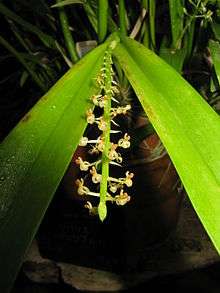Liparis condylobulbon
Liparis condylobulbon, commonly known as the tapered sphinx orchid[2] or 细茎羊耳蒜 (xi jing yang er suan)[3] is a plant in the orchid family. It is an epiphytic or lithophytic orchid with crowded, glossy green, cylinder-shaped pseudobulbs, each with two linear to lance-shaped leaves and between fifteen and thirty five pale green to cream-coloured flowers with an orange labellum. This orchid usually grows on trees and rocks in rainforest from Taiwan and Indochina to the south-west Pacific.
| Tapered sphinx orchid | |
|---|---|
 | |
| Liparis condylobulbon in the Osaka Prefectural Flowers Garden | |
| Scientific classification | |
| Kingdom: | Plantae |
| Clade: | Tracheophytes |
| Clade: | Angiosperms |
| Clade: | Monocots |
| Order: | Asparagales |
| Family: | Orchidaceae |
| Subfamily: | Epidendroideae |
| Tribe: | Malaxideae |
| Genus: | Liparis |
| Species: | L. condylobulbon |
| Binomial name | |
| Liparis condylobulbon | |
| Synonyms[1] | |
|
Synonyms
| |
Description
Liparis condylobulbon is an epiphytic or lithophytic, clump-forming herb with crowded, glossy green, cylinder-shaped pseudobulbs 80–150 mm (3.1–5.9 in) long and 10–20 mm (0.4–0.8 in) wide. Each pseudobulb has two thin, linear to lance-shaped leaves 80–200 mm (3.1–7.9 in) and 15–22 mm (0.6–0.9 in) wide. Between fifteen and thirty five pale green to cream-coloured flowers, 3.5–4.5 mm (0.14–0.18 in) long and 4–5 mm (0.16–0.20 in) wide are borne on a stiff flowering stem 70–150 mm (2.8–5.9 in) long. The sepals are 2.5–3 mm (0.098–0.12 in) long and about 1 mm (0.04 in) wide, the petals a similar length but narrower. The labellum is orange, about 3 mm (0.12 in) long and 2 mm (0.079 in) wide with a notched tip. Flowering occurs between December and August.[2][3][4][5]
Taxonomy and naming
Liparis condylobulbon was first formally described in 1862 by Heinrich Gustav Reichenbach who published the description in Hamburger Garten- und Blumenzeitung.[1][6][7]
Distribution and habitat
The tapered sphinx orchid grows on trees and rocks in rainforest. It is found in Taiwan, Myanmar, Thailand, Vietnam, Borneo, Java, the Lesser Sunda Islands, the Maluku Islands, the Philippines, Sulawesi, Sumatra, New Guinea, the Solomon Islands, Queensland, Australia, Fiji, New Caledonia, Samoa, Vanuatu, the Santa Cruz Islands and the Wallis and Futuna Islands. In Australia, it occurs on the Iron and McIlwraith Ranges.[1][2][5]
References
- "Liparis condylobulbon". World Checklist of Selected Plant Families (WCSP). Royal Botanic Gardens, Kew.
- Jones, David L. (2006). A complete guide to native orchids of Australia including the island territories. Frenchs Forest, N.S.W.: New Holland. p. 463. ISBN 1877069124.
- "Liparis condylobulbon". Flora of China. Retrieved 11 January 2019.
- "Cestichis condylobulbon". Trin keys: Australian Tropical Rainforest Orchids. Retrieved 11 January 2019.
- "Liparis condylobulbon". Orchids of New Guinea. Retrieved 11 January 2019.
- "Liparis condylobulbon". APNI. Retrieved 11 January 2019.
- Reichenbach, Heinrich Gustav (1862). "Liparis condylobulbon". Hamburger Garten- und Blumenzeitung. 18: 34. Retrieved 11 January 2019.